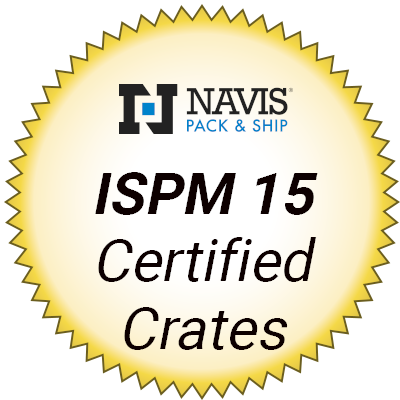Bob Gray, owner of Navis Pack & Ship of Raleigh, NC, recently shared his expertise with the art community in the Visual Art Exchange 2010 Winter Newsletter. VAE is Raleigh’s oldest non-profit visual arts organization, dedicated to serving emerging artists and enriching the cultural environment.
A Navis franchise operator since 2005, Bob offered advice on packing art and shipping art. Below is reproduction of the VAE News Exchange article.
At some point in your artistic career, you will probably have to ship your art. Bob Gray of Navis Pack and Ship (www.gonavis.com/nc1064) shared his advice for packing and shipping your artwork. Contact Bob at [email protected] or 919.832.9006 with questions.
Q: If you are packing art to ship yourself, what kind of packing materials do you recommend?
A: Depending on the nature and value of the work as well as the mode of transportation we would recommend the outer container be either corrugated or a wooden crate. Inside that container the work should be both surface protected and cushioned. Visqueen or a cellulose wrap are suitable surface protection for most works. Cushioning may take the form of bubble packaging, foam, or loose fill. Bubble packagingshould not be placed directly against any part of the work as it can leave a bubble pattern. If the work is being shipped to a gallery you should check with the gallery before using loose fill. Some galleries prohibit its use due to the clean up problems it creates for them, particularly when they are dealing with a large number of pieces before a show.
Q: Can you explain the different options for shipping work–how fast it will get there & how much it costs? What is the best way for an artist who is shipping a lot of work to ensure that the work gets where it needs to be on time without costing too much?
A: Domestic shipments can move via air or ground. International shipments can move via surface (ocean) or air. In both cases air is generally faster, safer, and more expensive. There are also specialized art transportation services available. These generally provide special handling including environmentally controlled vehicles. This adds to the cost making this mode of transportation best reserved for very high value work. One of the best ways to reduce cost is to plan ahead. By allowing some extra time the most economical method of packaging and transport that is appropriate can be used. Waiting until the last minute generally means faster transportation is required which increases cost.
Q: What are your recommendations for glass?
A: First glass should be masked with a glass mask material or at a minimum have some painters tape applied in a “X” pattern across the glass. This does not prevent breakage, but it does reduce the possibility of damage should the glass break by helping to hold it together. Once the glass is masked the piece should be surface wrapped, cushioned, and placed in a container like any other piece. This container should then be placed in an outer container with a minimum of two inches of cushioning material between the two containers.
Q: What are your recommendations for 3D/odd sized/fragile works?
A: Pieces of this nature really need to be handled on a case-by-case basis. Send us a picture along with the approximate weight, dimensions, value and destination to get a free estimate.
Q: What are the benefits to going through a shipper like Navis as opposed to USPS, UPS, FedEx, etc.?
A: Three reasons come to mind right away:
1. Whenever you use Navis you are taking advantage of our 25 years of art packaging and shipping experience. We can tailor the packaging and shipping to the specific situation.
2. Most carriers limit their transit coverage for art or other one-of-a-kind items. FedEx, for example limits it to $500. If the value of your piece is more than this you will not be covered by the carrier above the limit (even if you declare a higher value at the time of shipment). Navis’ declared value coverage will cover the actual value of the piece.
3. We have relationships with carriers who specialize in larger shipments. If you are shipping multiple pieces or a single larger piece we can leverage these relationships and provide very economical rates.
Q: How far out from a show’s opening date should an artist plan to ship their work?
A: We will happily accept any scheduling challenge that you present us with. However, to give you the very best rates we like to recieve the piece(s) 14 business days prior to the show’s due date.
Q: Are there certain materials that just don’t ship well?
A: A few materials may become damaged even if the best possible care is taken with them. These materials are collectively known as inherent vice and include stained glass, raku, and terra cotta pottery to name a few.
Q: What questions should an artist ask their shipper?
A: The artist should ask for (and receive) a free estimate of the costs. They should specifically ask how the piece will be packaged, how it will be transported, and how much (if any) declared value coverage is included. These things will generally determine the bulk of any cost differences when comparing estimates. For example, if one estimate is based on a wooden crate and another is based on a corrugated container there will likely be a significant difference in price. If declared value coverage is included the artist should ask if there is a deductible. If the piece needs to be delivered by a specific date the artist should ask if the quote includes a guaranteed delivery by that date.
Click here to read the entire VAE newsletter or visit the VAE website for additional information about the association and gallery. For more information on Navis Pack & Ship and shipping art, please explore our website.

